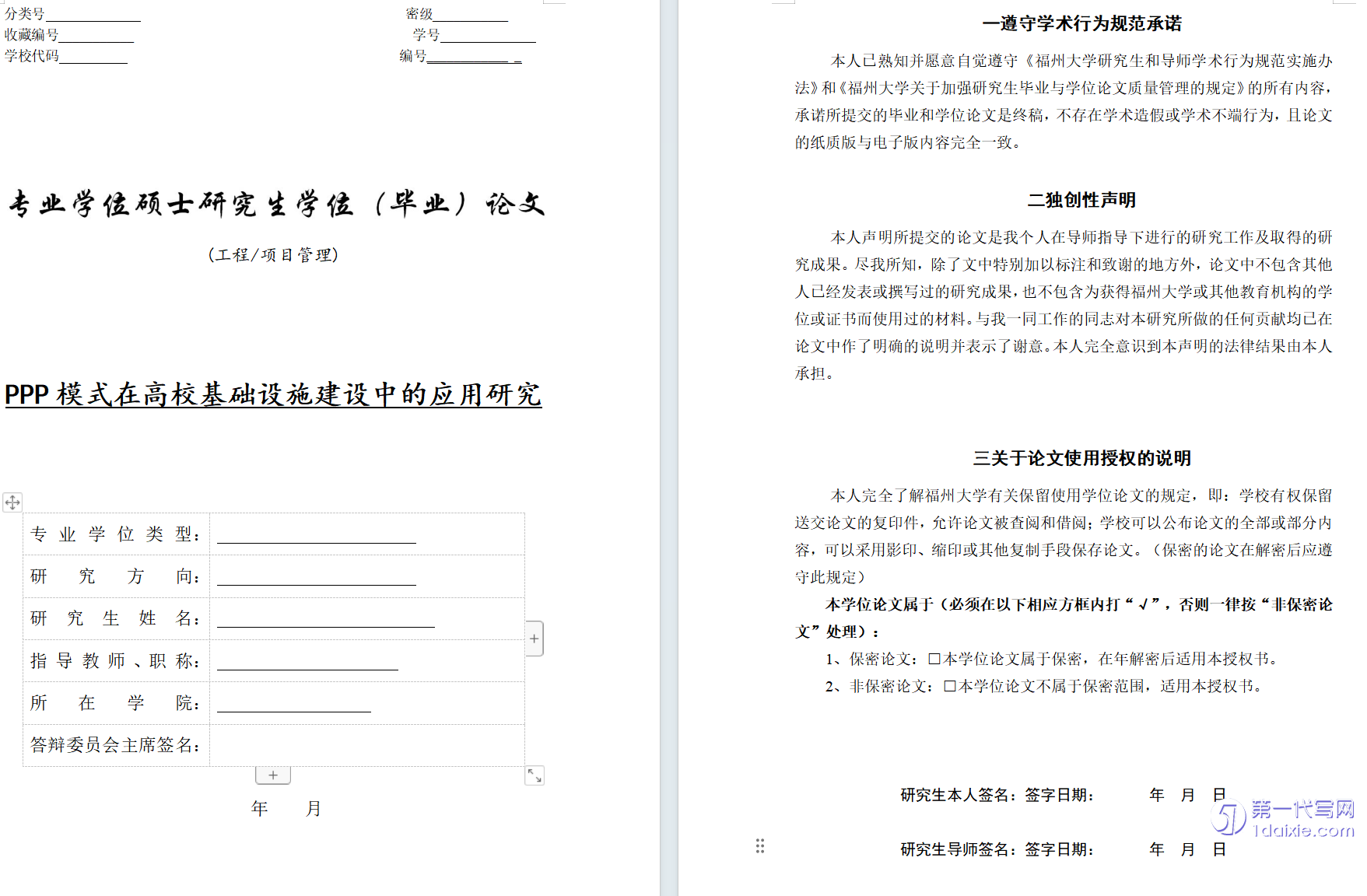
PPP模式在高校基础设施建设中的应用研究
摘要
据统计,到2020年,高等教育的毛入学率将增长至40%,我国受高等教育的人数将达2亿左右,在我国的全部人口中占有将近20%的比例。国内不少高校必须通过增加学校面积、构建新校区,大量采办教学设施才能解决现状。高等院校创建新校区虽然能获得不少利益,但同时亦将面临不小的风险与隐患。
PPP模式利用加入社会资本进入公共产品以及公共服务项目的投资与运作中,表现出社会资本的市场机制作用,有助于提高公共产品及服务的供给质量。大力推动PPP模式与高等院校基础设施中使用的研究,有利于增强社会在社会资源配置过程中所起到的决定作用,尽可能的展现出市场机制所具有的引导作用。
本研究以高校基础设施建设为具体研究对象,探讨PPP模式在其中的运用可操作性,以及改进策略。通过本文的研究,主要得出以下结论:
(1)PPP模式在高校基础设施建设中具有一定的优势,不但可以弥补财政预算不足,缓解高校债务压力,还可以在一定程度上缩短项目周期,提高运作效率。同时,还可以合理分担项目风险,实现高校和私企的合作共赢。
(2)将高校基础设施建设PPP项目根据执行的时间,将其划分为项目前期、项目建设期以及项目运营期,三个不同的时期,存在不同的风险,如项目前期存在融资风险、立项风险、设计风险、市场风险以及政策风险,宁德师范学院的PPP项目中,融资风险和立项风险于该阶段存在较高的风险值。在项目建设时期,存在完工风险、监督风险、市场风险以及政策风险,宁德师范学院的PPP项目中,完工风险和监督风险较大。项目运营期存在履约风险、经营风险、市场风险以及政策风险,宁德师范学院的PPP项目中,履约风险较大。
(3)为了更好的促进PPP模式在高校基础设施建设中的使用,降低项目风险,本篇文章中为其提出了相应的对策。首先,要合理分配风险,选择信用评级高的合伙人,同时全面建立风险防范体制。其次要健全投融资机制,包括鼓励多方主体参与,建立融资风险控制示范项目,以及拓宽融资渠道,提高资金使用率。再者,要加强政府监管职责,这不仅要引入竞争性的投招标制度,还要提高信息公开程度,加强公众参与度,同时还需要建立独立专业的监管机构,加强对项目的质量监管和价格监管。最后,要完善法律法规。
关键词:高校,基础设施,PPP模式,风险
Application Research of PPP Mode in University Infrastructure Construction
Abstract
According to statistics, by 2020, the gross enrollment rate of higher education will increase to 40%, and the number of higher education in China will reach 200 million, accounting for nearly 20% of the total population in China. Many colleges and universities in China must solve the current situation by increasing the school area, building a new campus, and purchasing a large number of teaching facilities. Although the establishment of a new campus in colleges and universities can gain a lot of benefits, it will also face no small risks and hidden dangers.
The PPP model uses the social capital to enter public goods and public service projects in the investment and operation, showing the role of social capital market mechanism, and help improve the quality of public goods and services. Vigorously promoting the research of PPP mode and the use of infrastructure in colleges and universities is conducive to enhancing the decision-making role played by society in the process of social resource allocation, and showing the guiding role of market mechanism as much as possible.
This study takes the university infrastructure construction as the specific research object, discusses the operational personality of the PPP model, and the improvement strategy. Through the research of this paper, the main conclusions are as follows:
(1) The PPP model has certain advantages in the infrastructure construction of colleges and universities. It can not only make up for the lack of budgetary budget, but also reduce the debt pressure of colleges and universities, and can shorten the project cycle to a certain extent and improve operational efficiency. At the same time, it is also possible to share the risk of the project reasonably and achieve the cooperation and win-win situation between the university and the private enterprise.
(2) PPP projects for university infrastructure construction are divided into pre-project period, project construction period and project operation period according to the time of implementation. There are different risks in three different periods, such as financing risks, project risks, design in the early stage of the project. Risk, market risk and policy risk. In Ningde Normal University's PPP project, the risk value of financing risk and project risk is higher at this stage. During the project construction period, there are completion risks, supervision risks, market risks and policy risks. In the PPP project of Ningde Normal University, the completion risks and supervision risks are relatively large. During the operation period of the project, there are performance risks, business risks, market risks and policy risks. In the PPP project of Ningde Normal University, the risk of compliance is relatively large.
(3) In order to better promote the application of PPP mode in university infrastructure construction and reduce project risk, this paper proposes corresponding countermeasures. First of all, it is necessary to rationally allocate risks, select partners with high credit ratings, and comprehensively establish a risk prevention system. Secondly, it is necessary to improve the investment and financing mechanism, including encouraging the participation of multiple parties, establishing financing risk control demonstration projects, and broadening financing channels to increase the utilization rate of funds. Furthermore, it is necessary to strengthen the government's supervisory responsibilities. This requires not only the introduction of a competitive bidding system, but also the improvement of information disclosure and public participation. At the same time, it is necessary to establish an independent professional regulatory body to strengthen the quality supervision and price of the project. Finally, we must improve laws and regulations.
Keywords: colleges and universities; infrastructure; PPP model; risk
目录
第1章 绪论
1.1研究背景和意义
1.1.1研究背景
1.1.2研究意义
1.2国内外研究现状
1.2.1国外研究现状
1.2.2国内研究现状
1.3研究方法和内容
1.3.1研究方法
1.3.2研究内容
1.4理论基础
1.4.1 PPP模式概况
1.4.2其他模式
1.4.3国内PPP模式运用存在的问题
第2章 高校基础设施建设运用PPP模式分析
2.1我国高校基础设施建设PPP模式运用的历程
2.2高校基础设施建设PPP模式的特点
2.2.1实施机构的特殊性
2.2.2项目完工风险大
2.2.3公共机构角色不同
2.2.4社会效益显现时间长
2.2.3运营的特殊性
2.3高校基础设施建设运用PPP模式的优势
2.3.1弥补财政预算不足,缓解高校债务压力
2.3.2缩短项目周期,提高运作效率
2.3.3合理分担风险,实现高校与私企的合作共赢
第3章 案例项目PPP模式评估
3.1案例项目概况
3.2项目PPP模式的风险评估
3.2.1评估方法—层次分析法
3.2.2层次结构构建
3.2.3指标权重确定
3.2.4案例项目PPP风险值
3.2.5案例学校PPP项目评估结果讨论
第4章 高校基础设施建设项目PPP模式运用的对策
4.1合理分配风险
4.1.1选择信用评级高的合伙人
4.1.2全面建立风险防范体制
4.2健全投融资机制
4.2.1鼓励多方主体参与
4.2.2建立融资风险控制示范项目
4.2.3拓宽融资渠道,提高资金使用率
4.3加强政府监管职责
4.3.1引入竞争性的投招标制度
4.3.2提高信息公开程度,加强公众参与度
4.3.3建立独立专业的监管机构
4.3.4加强对项目的质量监管
4.3.5加强对项目的价格监管
4.4完善法律法规
第5章 结论和展望
5.1研究结论
5.2研究展望
附录1 高校基础设施建设PPP模式应用的风险评估
附录2 宁德师范学院PPP项目风险评估
致谢
参考文献
致谢
攻读硕士期间发表的论文
